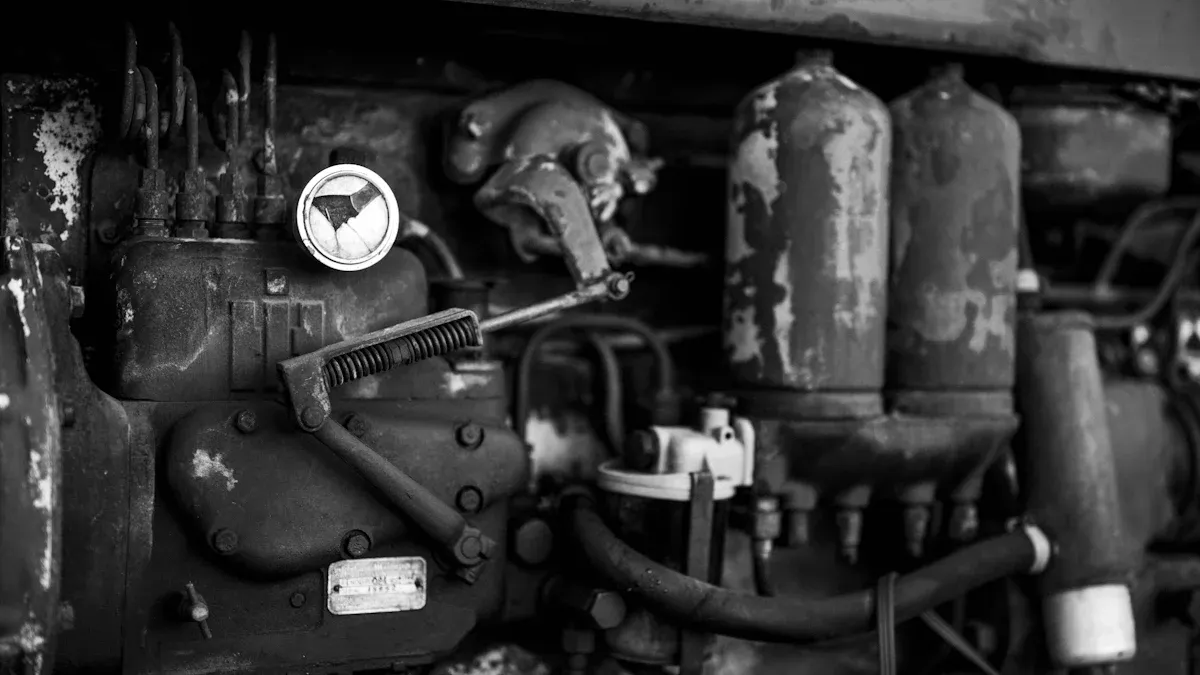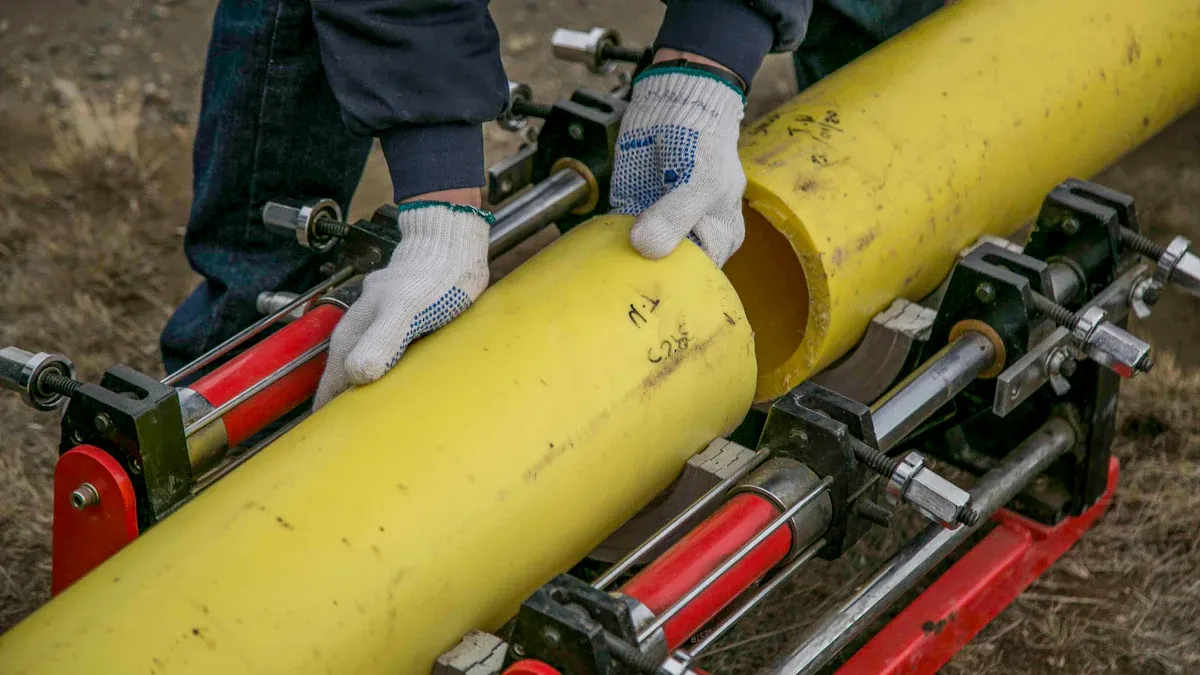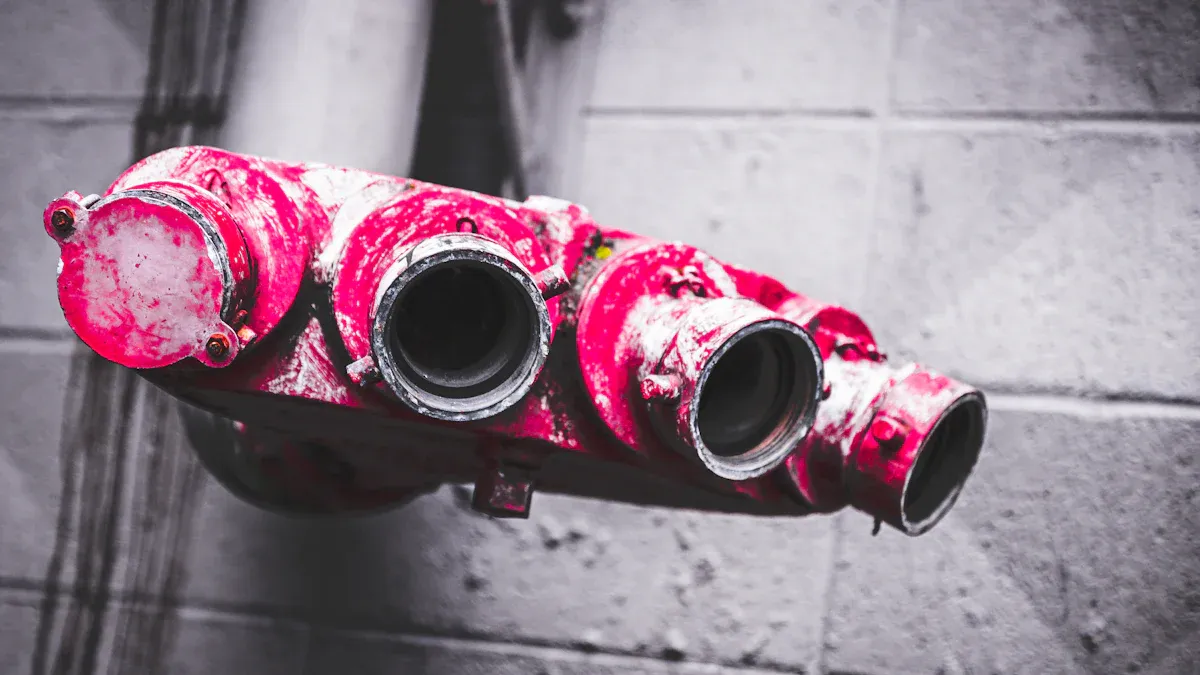
Hydraulic fittings play a big role in keeping machines safe and running smoothly. People see hundreds of hydraulic injection injuries each year, especially in North America. Take a look at the numbers:
| Region | Approximate Annual Incidents |
|---|---|
| North America | About 600 |
| Global | Higher, but underreported |
Choosing the right hydraulic hose fittings, stainless steel fittings, or flange fittings helps prevent leaks and injuries. A good hydraulic hose coupling can make a huge difference in safety.
Key Takeaways
- Always choose hydraulic fittings that meet ISO, DIN, or SAE standards to ensure safety and prevent leaks or accidents.
- Check material compatibility, pressure ratings, and sealing methods carefully to match your system’s needs and avoid failures.
- Perform regular inspections and maintenance, and use proper installation techniques to keep hydraulic fittings reliable and extend machine life.
Understanding Hydraulic Fittings Standards: ISO, DIN, and SAE

Overview of ISO, DIN, and SAE Standards
Hydraulic fittings come in many shapes and sizes, but not all of them follow the same rules. Three main standards guide their design: ISO, DIN, and SAE. Each standard has its own way of making sure fittings work safely and fit together. ISO 8434-1 covers a wide range of fittings, like compression, flare, and bite-type. These fittings focus on high quality and can handle strong vibrations and high pressure. DIN 2353, popular in Europe, uses metric sizes and metal-to-metal seals for a tight fit. SAE fittings, common in North America, use inch sizes and different sealing methods, such as O-rings and flares. These standards are not interchangeable because they use different threads and sealing styles. The choice depends on where the system will be used, the pressure it needs to handle, and what tools are available.
| Feature | DIN 2353 | SAE |
|---|---|---|
| Sizing System | Metric | Imperial (inch) |
| Sealing Mechanism | Metal-to-metal (cutting ring) | O-ring, flare, or mechanical seal |
| Thread Type | Metric threads | Unified National threads |
| Pressure Range | LL, L, S series for flexibility | Varies by fitting type (ORB, JIC) |
| Use Regions | Europe, global OEMs | North America |
| Reusability | High (durable metal seal) | Varies depending on seal type |
Why Standard Compliance Matters for Safety and Performance
Following the right standard for hydraulic fittings keeps machines safe and running well. When a fitting meets ISO, DIN, or SAE rules, it has passed tests for pressure, temperature, and durability. These tests help prevent leaks and failures. For example, SAE standards set strict rules for pressure ratings and material quality. This makes sure fittings can handle tough jobs without breaking. If someone uses the wrong fitting or ignores the standard, leaks or even accidents can happen. A real-world case showed that a worker got hurt because a fitting was not installed right. The injury led to surgery and showed how important it is to follow the rules. Using standard fittings also helps machines last longer and reduces downtime. In short, standard compliance means safer systems, fewer accidents, and better performance.
Evaluating Hydraulic Fittings: Criteria and Step-by-Step Process

Key Criteria: Material Compatibility, Pressure, Temperature, and Sealing
Choosing the right hydraulic fittings starts with understanding what makes them safe and reliable. The main things to look at are the material, pressure rating, temperature range, and sealing method.
- Material CompatibilityNot all materials work well with every hydraulic fluid or environment. Here’s a quick look at common materials and their properties:
Material Key Properties Effect on Compatibility with Hydraulic Fluids Steel Strong, durable, corrosion resistant Great for high-pressure jobs; needs corrosion protection Stainless Steel Strong, corrosion resistant Handles harsh environments and most fluids Brass Machinable, corrosion resistant Good for low to medium pressure; resists many chemicals Aluminum Lightweight, corrosion resistant Used where weight matters; best for low pressure Plastic Chemical resistant, fair strength Only for low-pressure, special uses Chemical compatibility is a must. If the fitting material reacts with the hydraulic fluid, it can corrode or break down. Always check manufacturer charts to make sure the material matches the fluid and environment.
- Pressure and Temperature RatingsHydraulic fittings must handle the system’s pressure and temperature. For example, fittings under SAE J514 and ISO 11926 standards have pressure ratings based on a 4:1 safety factor. A 1/4-inch fitting might be rated for 5,000 psi, while a 3/8-inch fitting could be rated for 3,000 psi. The lowest-rated part sets the limit for the whole connection. Most hoses and fittings work from -40°C to +125°C. If you use a fitting outside its rated range, it can crack, leak, or even burst.
- Sealing MechanismThe way a fitting seals is just as important. Some use metal-to-metal contact, while others use O-rings or flares. The right seal keeps fluid in and dirt out. Always match the seal type to the system’s needs and check for wear or damage before use.
Tip: Always double-check the fitting’s pressure and temperature ratings. Using the wrong rating can lead to leaks, equipment damage, or even injuries.
Step-by-Step Evaluation: Certification, Markings, and System Matching
Evaluating hydraulic fittings is easier when you follow a clear process. Here’s a step-by-step guide:
- Check Certification and AuthenticityLook for markings that show the fitting meets ISO, DIN, or SAE standards. Manufacturers provide certificates and traceability records. Only buy from trusted sources to avoid counterfeit parts.
- Inspect Markings and LabelsEach fitting should have clear markings for size, pressure rating, and standard. These help you match the fitting to your system and spot any mix-ups.
- Match to System Requirements
- Figure out the system’s flow and pressure needs.
- Pick a hose and fitting size that supports the flow and pressure.
- Make sure the fitting material matches the fluid and environment.
- Check that the thread type and sealing method fit your system.
Factor Category Key Considerations Impact on Matching Hydraulic System Requirements with Fittings Fluid Properties Viscosity, temperature Choose fitting size and material for smooth flow and durability System Pressure Requirements Pressure ratings Prevent leaks and failures Pipe and Hose Specifications Diameter, wall thickness, material Ensure proper fit and strength Compatibility with Components Thread types, material compatibility Avoid leaks and mismatches Flow Rate Requirements Calculated flow rates Prevent turbulence and pressure drops Environmental Conditions Temperature, chemicals, abrasion Pick materials that last in tough conditions - Test Before UseAfter installation, pressurize the system and check for leaks. Use leak detection solutions or dyes if needed. Make sure all connections are tight and secure.
Note: Manufacturers often require visual inspections, pressure tests, and even burst tests to make sure fittings are safe before use.
Common Pitfalls and How to Avoid Them
Even experienced technicians can make mistakes with hydraulic fittings. Here are some common problems and how to dodge them:
- Forgetting Environmental and Chemical ResistanceSome people skip checking if the fitting can handle UV, chemicals, or extreme temperatures. Always pick materials that match the environment.
- Skipping MaintenanceNot checking fittings regularly leads to unnoticed leaks or wear. Set up a schedule for inspections and replacements.
- Poor Installation PracticesOver-tightening can crush seals or strip threads. Under-tightening leaves gaps for leaks. Use the right tools and follow torque specs.
- Mixing Up ThreadsUsing the wrong thread type (like mixing BSPP and NPT) causes cross-threading and leaks. Always verify thread types before assembly.
- Ignoring System CompatibilityIf the fitting doesn’t match the system’s flow, pressure, or vibration needs, it can fail early. Review all system specs before choosing a fitting.
Alert: Most leaks come from improper installation, damaged seals, or contamination. Clean parts, use the right tools, and follow best practices every time.
Maintenance and Ongoing Safety Checks
Keeping hydraulic fittings in top shape means regular care and smart monitoring. Here’s how to stay ahead:
- Routine InspectionsCheck for leaks, cracks, or wear every day in high-risk systems. Do weekly or monthly checks for less demanding setups. Use visual checks, pressure tests, and even advanced tools like ultrasound for hidden problems.
- Preventive MaintenanceReplace worn parts, seals, and hoses before they fail. Never reuse old O-rings or hoses. Keep records of all maintenance and replacements.
- Training and EducationMake sure everyone who works with hydraulic fittings knows the right way to install and check them. Training helps prevent mistakes and keeps the system safe.
- Digital MonitoringMany modern systems use sensors to track pressure, temperature, and flow. These sensors send alerts if something goes wrong, so you can fix issues before they cause trouble.
- Cleanliness and Fluid CareUse only clean hydraulic fluid. Change filters on schedule and keep the system free from dirt and water. Store fluids in clean, dry places.
- Follow Lockout/Tagout ProceduresAlways shut down and depressurize the system before working on it. This prevents accidents and injuries.
| Usage Intensity / System Type | Inspection Frequency | Inspection Type / Notes |
|---|---|---|
| Critical / High-Risk Systems | Daily | Visual checks for leaks, cracks, wear |
| Weekly | Pressure testing and fittings check | |
| Monthly | Advanced inspections (infrared, ultrasound) | |
| Moderate Use | Weekly | Visual checks |
| Bi-weekly | Pressure tests | |
| Monthly | Detailed inspections | |
| Light Use | Pre-use | Visual checks before each use |
| Monthly | Physical inspections | |
| Quarterly | Comprehensive inspections |
Tip: Digital monitoring and regular checks help catch problems early. This keeps your hydraulic system safe and running longer.
Consistent evaluation of hydraulic fittings keeps machines safe and efficient.
- Certificates like EN 10204 3.1 or 3.2 prove compliance with ISO, DIN, or SAE standards.Regular checks and good records help spot problems early, lower costs, and boost system uptime. A structured process means fewer leaks, less downtime, and better performance.
FAQ
What happens if someone uses a fitting that does not meet ISO, DIN, or SAE standards?
A fitting that does not meet standards can leak or break. This can cause machine failure or even injury.
How can a person tell if a hydraulic fitting is genuine?
They should look for clear markings, check for certificates, and buy only from trusted suppliers. Counterfeit parts often miss these details.
Why do hydraulic fittings need regular checks?
Regular checks help spot leaks, cracks, or wear early. This keeps machines safe and prevents costly breakdowns.
Post time: Jul-11-2025
